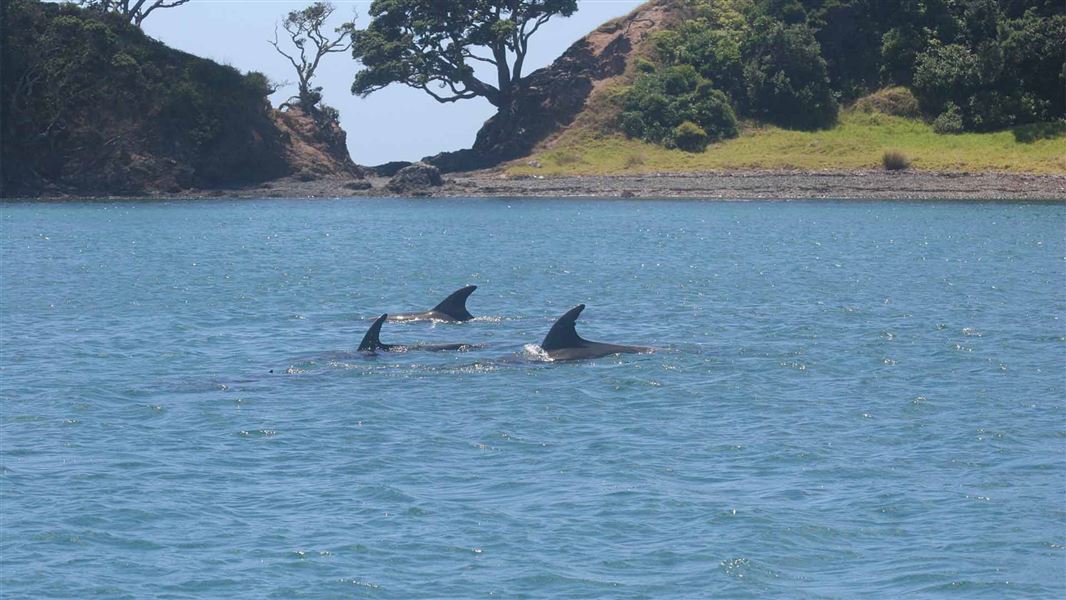Restrictions for this marine mammal sanctuary.
User guidance: Te Pēwhairangi/Bay of Islands marine mammal sanctuary.(PDF, 522K)
The Bay of Islands is declared as a Marine Mammal Sanctuary under the Marine Mammals Protection Act 1978. This was gazetted on 17 November 2021 by the Minister of Conservation and came into effect on 15 December 2021.
Image gallery
Places you can visit while you're in the Bay of Islands:
The Bay of Islands is a key tourism destination in Northland. It provides a number of recreational opportunities for boating, diving, snorkelling, and fishing. It also has a rich cultural history and a range of opportunities to see wildlife.
Coastal towns including Paihia, Russell and Kerikeri provide key sanctuary access points.
Keep marine mammals in the Bay of Islands safe by following the restrictions. All marine mammals are fully protected.
Organise marine events
The Bay of Islands is declared as a marine mammal sanctuary under the Marine Mammals Protection Act 1978. This was gazetted on 17 November 2021 by the Minister of Conservation and comes into effect on 15 December 2021.
Purpose of the sanctuary
The purpose of the Bay of Islands Marine Mammal Sanctuary is to:
- reduce known pressures on marine mammals, and
- give them the opportunity to visit the waters of the Bay of Islands safely.
The sanctuary restrictions intend to protect all marine mammals from interactions with vessels and people. The creation of safe zones give marine mammals designated areas of quiet. This gives them space to do their normal behaviours, including feeding and nursing, free from human distractions.
Bottlenose dolphins are being viewed as an indicator species - research shows a reduction in survival critical behavioural and a drop in the number of bottlenose dolphins visiting the Bay of Islands.
An indicator species is one whose presence and use of an area tells us more about the condition of a specific environment. In this case, they tell us more about the condition of the Bay of Islands marine environment. The sanctuary aims to protect all marine mammals and contribute to a thriving marine ecosystem.
Research about the issues:
- Land-based monitoring of the Te Pēwhairangi Marime Mammal Sanctuary - Two-month status update April 2025 (PDF, 1,129K)
- 2025 Update on the population and spatial ecology of bottlenose dolphins in the Bay of Islands (PDF, 3,606K)
- 2022 Identifiable individuals, behavioural responses to vessel activity and calf survival of bottlenose dolphins in Far North waters (PDF, 5,073K)
- 2020 research bottlenose dolphin in far north water New Zealand
- 2016 research on responses of bottlenose dolphin to vessel activity in Northland
How it’s managed
The sanctuary is managed by a DOC-hapū advisory committee. This committee makes management decisions and recommendations in line with the Marine Mammals Protection Act 1978. This joint management shows DOC’s commitment to give effect to the principles of the Treaty of Waitangi.
The sanctuary was developed in partnership with a collective of Te Pēwhairangi hapū. This was informed by key research including 2016 research which details the effects of vessel interactions on bottlenose dolphin. The marine mammal sanctuary was created through a consultation process.
Mātauranga Māori and the management of Te Pēwhairangi (Bay of Islands) marine mammals
Mana whenua have extensive knowledge of Te Pēwhairangi (Bay of Islands) marine mammals – their life cycles, roles and interrelationships within ecosystems and tikanga/cultural practices. Acknowledging whakapapa and including mātauranga Māori is key to managing marine mammals in Te Pēwhairangi (Bay of Islands).
As stated by Robert Willoughby, Te Pēwhairangi hapū member:
“Mātauranga Māori encompasses a holistic world view. It starts from the heavens, comes down to earth and covers everything in between. Our ancestors imparted knowledge to us in waiata, legends and chants and there are words that keep being emphasised like whakapapa, mauri, oranga and kaitiakitanga.
These all have relevance to the current kaupapa in front of us right now and are a major part of the long-term solution we are seeking. However, He Whakaputanga 1835 and Te Tiriti o Waitangi 1840, Article 2, is also part of our narrative.
Without delving into the details and the vastness of that history, it may just suffice to say that the intention and spirit of Te Tiriti was and still is to work together in partnership and to build a great nation.
Through this proposed marine mammal sanctuary, Mana Whenua and the Crown would have a perfect opportunity to set an example of working together on a common goal and to achieve a worthy outcome which is to protect and sustain our taonga, the dolphins.”
Working in partnership Mahinga rangapū
"The bottlenose dolphin is a taonga species for Te Pēwhairangi hapū. They are kaitiaki, protectors (guardians) of our people. Tohunga were known to call the dolphins. They are a gauge on the health of our fishery and moana and represent the closeness of the whanau.”
DOC Customer Service Centre
| Phone: | 0800 275 362 |
| Email: | bayofislands@doc.govt.nz |
| Address: | Pewhairangi / Bay of Islands Office |
